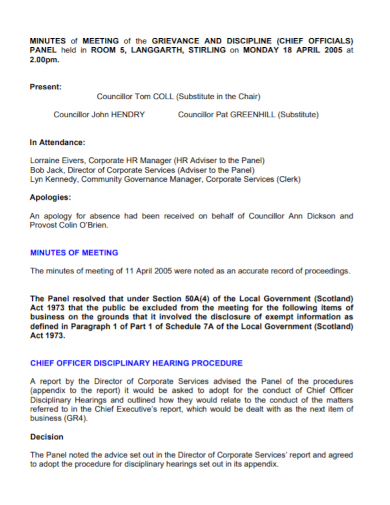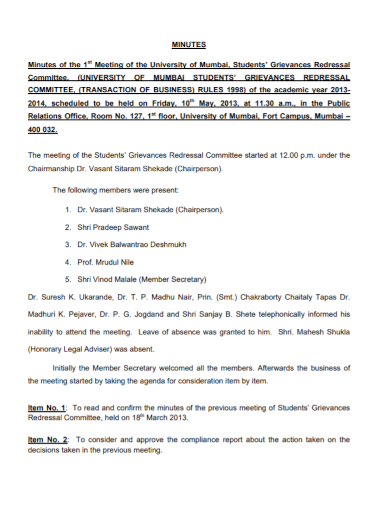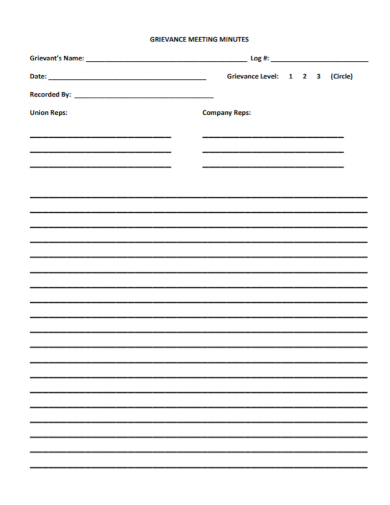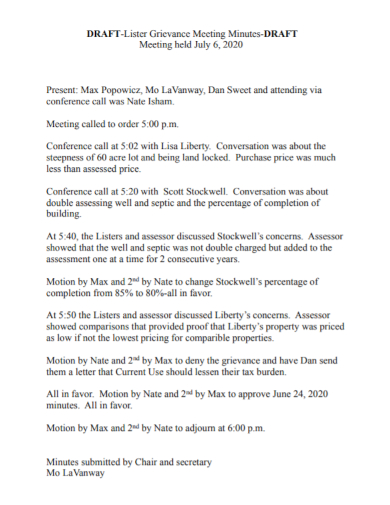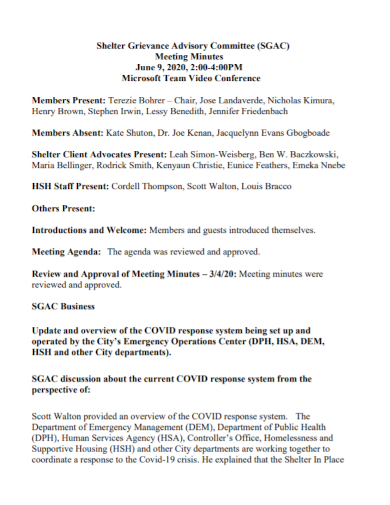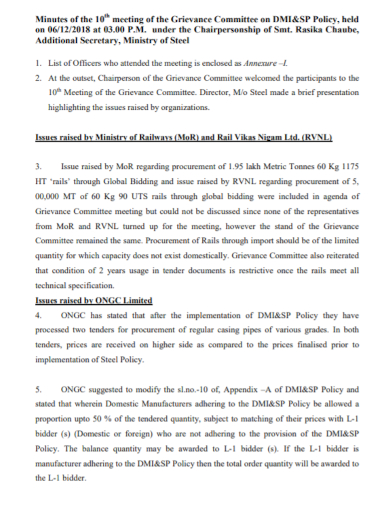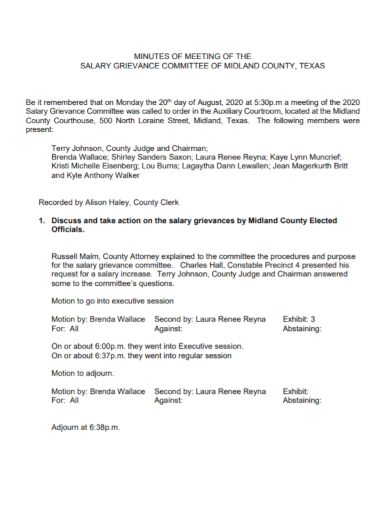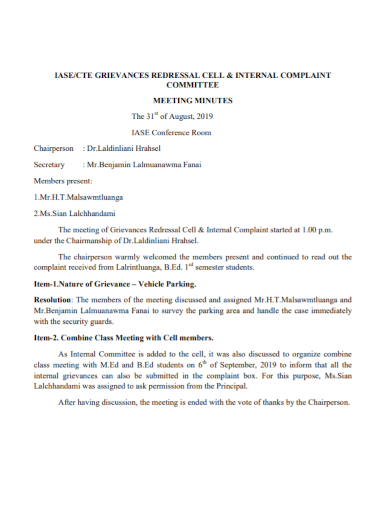It is paramount for every team, company, business, organization, any working body of group or body of people to be able to establish a clear medium for communications. Members or employees, and managers alike. Proper communication in the workplace is very important since you’ll be interacting with the same faces and the same people for the majority of your day. Any grievances or issues that you might have with them or with the company should be resolved immediately to prevent it from becoming a hindrance in work operations. Every workplace, every business, every group has their own fair share of grievances and issues between their workforce.
That is why most company managers or team leaders conduct grievance meetings or grievance hearings to try and help resolve these issues that might have been raised by an employee. And in order to further supplement this intervention, or just like any other meeting, minutes of the meetings have to be drafted
Minutes of the meeting are documents that contain notes of the issues and the events that transpired during the meeting. This help highlight these issues and their discussions, motions that have been raised or decisions made, and the tasks or progress that need to be accomplished. It serves as an outline of the events that have happened, and also a written record for those who were not able to attend the hearing. Meeting minutes are relatively important tools to have, especially in workspaces that typically consists of a large number of people.
For more important meetings in the workplace like emergency meetings, project meetings, and grievance hearings. Minutes can help record and disseminate any relevant information to the rest of the company. It also acts as a solid reference point for the next meetings hereafter. To properly acquaint yourself with what a grievance meeting minutes is and how it works, check out these samples that we have listed down below. Once you’ve familiarized yourself with the document, you can then use these samples as guides or even as templates for when you’re drafting your own minutes of the meeting.
10+ Grievance Meeting Minutes Samples
1. Grievance Discipline Meeting Minutes
2. Grievance Meeting Minutes
3. Student Grievance Meeting Minutes
4. Company Grievance Meeting Minutes
5. Sample Grievance Meeting Minutes
6. Grievance Redressal Meeting Minutes
7. Grievance Advisory Committee Meeting Minutes
8. Grievance Committee Meeting Minutes
9. Salary Grievance Meeting Minutes
10. Grievance Cell Meeting Minutes
11. Grievance Community Meeting Minutes
What Is a Grievance Meeting Minutes?
Grievance meeting minutes are just essentially minutes of the meeting, only drafted specifically for grievance meetings. They contain and operate with the same elements, only the contents and the context of which it is used are different. These are official documents that contain a written record of the topics that were discussed and the events that have transpired during the duration of the meeting. It can serve multiple purposes as well like tracking the overall progress of the group, provide details for future tasks or progress that need to be made, and serve as a solid reference point for future grievance hearings.
It contains details of the meeting like a list of the attendees, the motions raised and the decisions made, and if any of the employee’s grievances were ever resolved. It’s a summary of events, less of a transcript of verbatim words. Committees tend to have a person assigned to take down the minutes of the meeting, usually the secretary of the board.
What Should Be Included in a Group Meeting Minutes
The appointed taker of the minutes of the minutes of the meeting should have a clear idea of what their task is and how they’re supposed to do it. It is best to consult the meeting presider or the board president whenever unsure. A good example for this is when a motion is raised during the meeting, they should clarify whether or not they’ll include the names of those who approved and declined in the tally. And before actually writing information down, it is best to be familiar with the pieces of information that you’ll be dealing with. Some committees have their own formats and parameters in writing such document, but regardless it should contain the following details.
- Date
- Write the date and time of when the meeting took place. Use a proper and appropriate dating format.
- Attendance
- List the names of who were present and absent, make a list for those who were tardy as well.
- Clarifications regarding the minutes of the previous meeting
- Take note of the clarifications made or the inquiries regarding the minutes of the last meeting. And whether or not everybody agrees with it.
- Decisions and motions for the current agenda
- Tasks that need to be completed or talked about
- Steps and proceedings moving forward
- Outcome of decision making
- Ideas rejected or approved
- Old, and recent grievances
- Details for the next hearing such as date and time, and agenda
Once the meeting ends, the taker of the minutes of the meeting should then be able to gather the information they need to write the minutes in a clear and comprehensive manner. Merely writing the information down on a piece of paper wouldn’t count as a minutes of the meeting, that would just be your notes. A minutes of the meeting actually has to be summarized and presenting it in a comprehensive manner. Make sure to draft the final minutes of the meeting while the information is still fresh in your mind. Review all the information and the contents, out line the important parts, and seek clarification when needed.
FAQs
What do you say in a grievance meeting?
- Explain your side
- Express how you feel
- Ask relevant questions
- Show evidence
- Provide details of any witnesses
What are helpful tips for taking the minutes of the meeting?
- Use a template like the ones we’ve provided above
- Take note of people’s attendance as they arrive
- Organize any list you make
- Keep track of the events as they happen
- Seek clarification when unsure or confused
- Make the notes clear and easily comprehensible
Do I have to participate a grievance meeting?
A grievance meeting should be held without any delay. Affected members of the group or company should make an effort to attend this meeting.
Minutes of the meetings are widely sought after documents, with most if not all managers requiring them every after a meeting. It’s a very useful tool, not just for recording information and information dissemination, but also for archival purposes as well. Especially when dealing with matters that affect the personal lives of the employees.
Related Posts
FREE 10+ Covid 19 Meeting Minutes Samples in MS Word | Google Docs | Apple Pages | PDF
FREE 10+ Trustee Meeting Minutes Samples in MS Word | Google Docs | Apple Pages | PDF
FREE 10+ Small Business Meeting Minutes Samples in MS Word | Google Docs | Apple Pages | PDF
FREE 10+ Company Meeting Minutes Samples in MS Word | Google Docs | Apple Pages | PDF
FREE 10+ Board Meeting Minutes Samples [ Non Profit, First, Software ]
FREE 10+ Risk Management Meeting Minutes Samples in PDF | DOC
FREE 10+ Office Meeting Minutes Samples in PDF | DOC
FREE 10+ Nurses Meeting Minutes Samples in PDF | DOC
FREE 10+ Marketing Meeting Minutes Samples in PDF | DOC
FREE 10+ Pre-construction Meeting Minutes Samples in PDF | MS Word | Google Docs | Apple Pages
FREE 10+ Weekly Meeting Minutes Samples [ Sales, Staff, Safety ]
FREE 10+ Faculty Meeting Minutes Samples in PDF | DOC
FREE 10+ Event Meeting Minutes Samples in PDF | DOC
FREE 11+ Team Meeting Minutes Samples [ Leadership, Remote, Project ]
FREE 10+ Operations Meeting Minutes Samples in PDF | DOC

